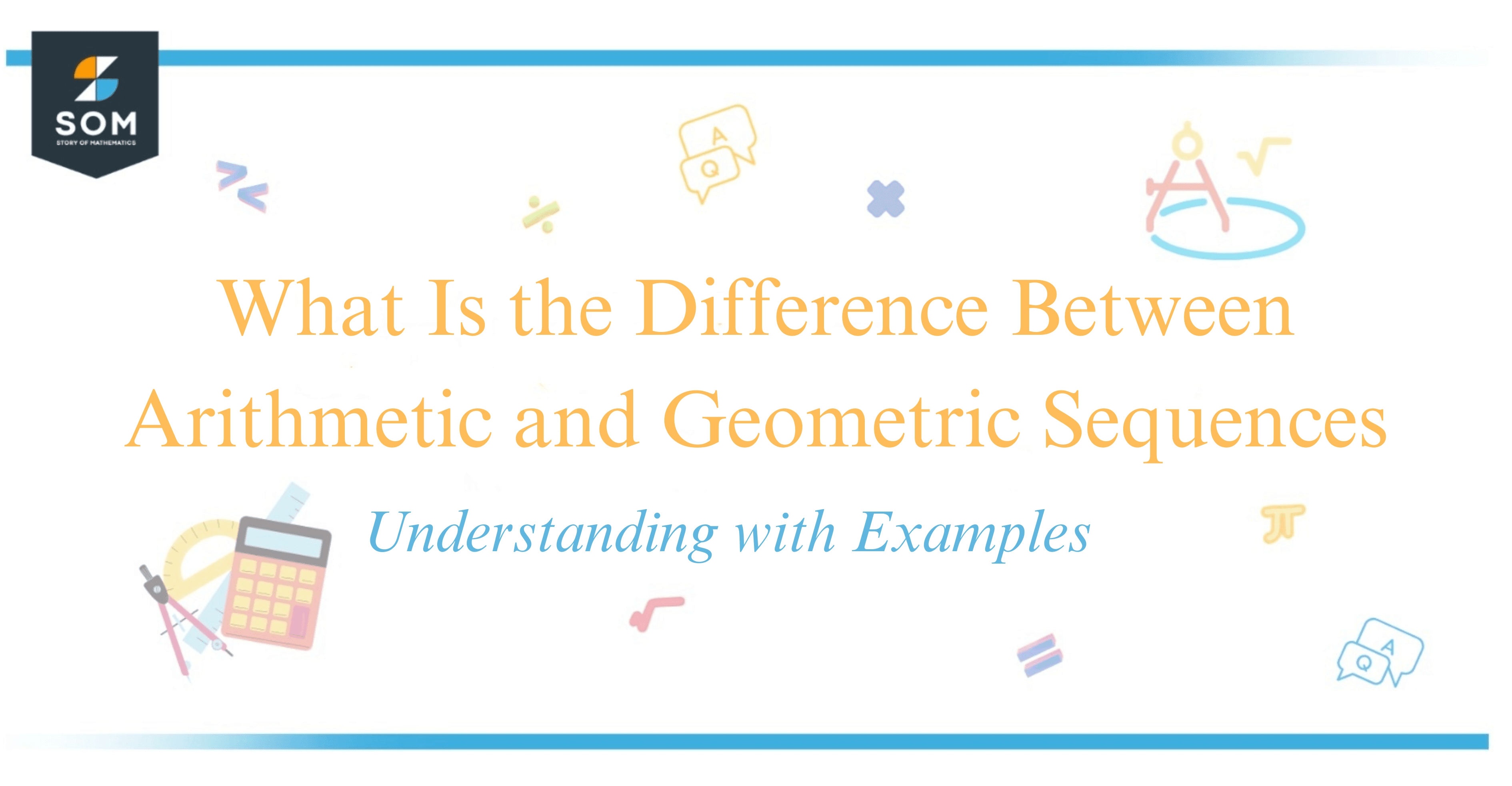JUMP TO TOPIC

Arithmetic and the geometric sequence are fundamental concepts in mathematics, featuring an ordered list of numbers where each term relates to its predecessor through a specific pattern. In an arithmetic sequence, the difference between consecutive terms is constant, such as in the series (5, 11, 17, 23), where each number increases by 6.
Contrarily, a geometric sequence is defined by a constant ratio between successive terms—for example, ($2, 4, 8, 16), where each term is the previous one multiplied by 2. My fascination with these patterns lies in their wide-ranging applications, from simple savings calculations to complex physics problems.
Main Differences Between Arithmetic and Geometric Sequences
The main differences between arithmetic and geometric sequences are their methods of generating terms and their growth patterns. In arithmetic sequences, each term increases by a constant difference, whereas in geometric sequences, each term is multiplied by a constant ratio.

Arithmetic sequences are numerical patterns where the difference d between consecutive terms is constant. If the first term $a_1$ is known, any term $a_n$ in the sequence can be found using the formula: $a_n = a_1 + (n – 1)d$
For example, in the sequence (2, 4, 6, 8, 10…), each term is obtained by adding 2 to the preceding term, making it an arithmetic sequence with a common difference ((d)) of 2.
Geometric sequences, on the other hand, are defined by a constant ratio (r) between successive terms. A term in a geometric sequence can be calculated from the first term $a_1$ using: $a_n = a_1 \cdot r^{(n – 1)}$
For instance, (3, 9, 27, 81, 243…) is a geometric sequence, where each term is obtained by multiplying the previous term by 3, hence a common ratio ((r)) of 3.
| Arithmetic Sequence | Geometric Sequence | |
|---|---|---|
| Relation | Additive | Multiplicative |
| First Term | $(a_1)$ |
Key Formulas and Calculations
When I work with arithmetic sequences, I use a specific formula to find any term. This general formula for an arithmetic sequence is:
$a_n = a_1 + (n – 1)d$
Here, $a_n$ is the $n^{th}$term, $a_1$ is the first term, and $d$ is the common difference between terms. I calculate this difference through subtraction of any two consecutive terms.
For example, if I have an arithmetic sequence starting with 1, and the common difference is 3, the sequence looks like this:
1, 4, 7, 10, …
To find the 5th term $a_5 $, I use the formula:
$a_5 = 1 + (5 – 1) \times 3 = 13$
On the other hand, geometric sequences require multiplication or division. The geometric sequence formula to determine the$n^{th}$ term is:
$a_n = a_1 \times r^{(n-1)}$
In this formula, ( r ) represents the common ratio I find by division of any term by the previous term.
For instance, if my first term $a_1$ is 2 and my common ratio is 3, the sequence appears as:
2, 6, 18, 54, …
To find the 4th term $a_4 $, I use the formula:
$a_4 = 2 \times 3^{(4-1)} = 2 \times 27 = 54$
If I’m dealing with the sum of a finite geometric sequence, I use the sum formula:
$S_n = \frac{a_1 (1 – r^n)}{1 – r}$
This is helpful when I need the sum of all terms up to a particular point, as long as $ r \neq 1$.
In summary, these formulas help me calculate specific terms and sums in both arithmetic and geometric sequences effectively.
Understanding Sequence Behaviors
In the realm of mathematics, I find it’s essential to differentiate between arithmetic and geometric sequences, as their behaviors dictate their application and conceptual understanding. Let’s begin with arithmetic sequences, where the defining characteristic is the constant difference between consecutive terms. This means if I have a sequence starting with a number, say $a$, the next term is found by adding a common difference $d$ to it:
$$a, a + d, a + 2d, a + 3d, \dots$$
If the sequence is infinite, the terms will diverge if $d$ is not zero, meaning they’ll keep increasing or decreasing without bound, signifying indefinite growth or decrease.
Now, let’s talk about geometric sequences, which are quite fascinating due to their exponential growth or decay. Here, each term is found by multiplying the previous term by a common ratio $r$. A sample geometric sequence looks like this:
$$a, a \cdot r, a \cdot r^2, a \cdot r^3, \dots$$
For infinite geometric sequences, convergence or divergence is based on the value of $r$. If $|r| < 1$, the terms will converge towards zero, while $|r| > 1$ signals that the terms will diverge, either towards infinity or negative infinity.
| Sequence Type | Behavior | Term Relationship | Divergence/Convergence |
|---|---|---|---|
| Arithmetic | Linear Growth | Constant Difference | Diverge (if $d \neq 0$) |
| Geometric | Exponential Growth | Constant Ratio | Converge (if $d =0$) |
In terms of finite sequences, while arithmetic sequences will have a clear start and end with terms either increasing or decreasing by a fixed amount, finite geometric sequences have a multiplying factor determining the rate of increase or decrease of the terms.
This might not be as straightforward to visualize, but it’s this exponential factor that often makes geometric sequences more dynamic than their arithmetic counterparts.
Applications in Real Life
When I explore my daily life, I notice that arithmetic and geometric sequences are the backbone of many regular occurrences. In an arithmetic sequence, there’s a common difference (d) between consecutive terms, such as the incremental growth of my savings account when I consistently deposit the same amount of money every month.
The nth term of an arithmetic sequence can be represented as:
$$a_n = a_1 + (n-1)d$$
Where a1 is the first term, n is the term number, and d is the common difference.
On the other hand, a geometric sequence has a common ratio (r) between consecutive terms. This can be observed in scenarios like compound interest on an investment, where my balance grows by a certain percentage each period. The nth term of a geometric sequence is given by:
$$a_n = a_1 \cdot r^{(n-1)}$$
For instance, if I invest money in an account that offers compound interest, the amount compounds based on a geometric sequence. The general formula for the sum of the first n terms of a finite geometric series is:
$$S_n = \frac{a_1(1 – r^n)}{1 – r}$$
This formula calculates the total accumulated value, including interest.
| Sequence Type | Real World Application | Example |
|---|---|---|
| Arithmetic | Saving Money | Adding a fixed amount to savings each month. |
| Geometric | Population Growth | Bacteria in a lab culture doubling in number at regular intervals. |
| Geometric | Investment Growth | Compound interest increasing an investment balance. |
Consequently, understanding these sequences helps me manage my finances better through savings and investments, and allows me to grasp how populations can exponentially increase under ideal conditions, affecting resources and space.
Conclusion
In summarizing the characteristics of arithmetic and geometric sequences, I find it fascinating how these fundamental patterns manifest so differently. An arithmetic sequence is defined by the addition or subtraction of a constant value, referred to as the common difference.
Mathematically, you can express this as an equation for the $n$th term, $a_n = a_1 + (n-1)d$, where $a_1$ is the first term and $d$ is the common difference.
On the other hand, a geometric sequence is created by multiplying each term by a fixed value, known as the common ratio. You can represent the $n$th term of a geometric sequence by the formula $a_n = a_1 \cdot r^{(n-1)}$, with $a_1$ as the first term and $r$ as the common ratio.
Let’s look at brief examples: An arithmetic sequence could start at $1$ and keep adding $3$, so the sequence is $1, 4, 7, 10,\dots$. In contrast, starting a geometric sequence with $2$ and multiplying by $3$ each time gives us $2, 6, 18, 54,\dots$.
Remember that the arithmetic sequence maintains a linear growth, comparable to an unchanging stride in a walk. Meanwhile, the geometric sequence shows exponential growth, similar to how interest compounds in a bank account. These differing structures make each type of sequence suitable for various situations in mathematics and real-life applications.
